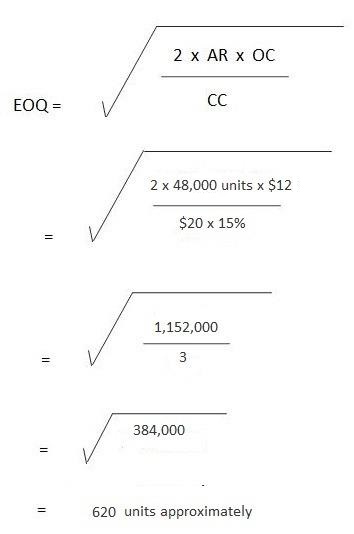Problem 3 A manufacturing company places a semi-annual order of 24,000 units at a price of $20 per unit. Its carrying cost is 15% and the order cost is $12 per order.
Problem 3
A manufacturing company places a semi-annual order of 24,000 units at a price of $20 per unit. Its carrying cost is 15% and the order cost is $12 per order.
Required:
- What is the most economical order quantity?
- How many orders need to be placed?
Solution

No. of orders per year = Annual Requirement / EOQ
= 48,000 units / 620 units
= 77 orders approximately
To compute the annual requirement:
24,000 units are ordered semiannually, therefore:
Annual requirement = 24,000 units x 2 = 48,000 units.
Economic Order Quantity (EOQ): Practical Problems and Solutions FAQs
What is the Economic Order Quantity (EOQ) formula?
EOQ stands for economic order quantity. The formula is: EOQ = √ (2xARxOC) / CC where AR = annual requirements, OC = per unit cost, and CC = carrying cost per unit per year of materials inventory
What does “efficient” mean? Explain why it is so helpful in business.
Efficient means to use the minimum resources to achieve a goal. In this case, it means minimizing your inventory amount. It is helpful because it decreases the money you spend on holding inventory, and lowers the risk of not having enough inventory if a sudden increase was to happen.
What are some examples of Economic Order Quantity (EOQ) applications in real life?
Clothing stores order a certain amount in inventory at a time to save on costs. A clothing store, for example, has an EOQ of 10 and sales are going well. If the owner wanted to make more money or generate more sales, they would increase that EOQ amount so they won’t have to keep placing orders as often, saving them time and money in the process.
What are the advantages of calculating Economic Order Quantity (EOQ)?
It minimizes carrying costs and saves time. You can also save a substantial amount of money using this method since you would not have to place as many orders reducing supplier lead time
What are the disadvantages of calculating Economic Order Quantity (EOQ)?
EOQ does not account for seasonal or economic fluctuations which can cause huge differences in your inventory levels. It does not take into account the random nature of demand.

About the Author
True Tamplin, BSc, CEPF®
FacebookLinkedinInstagramTwitterYoutube
True Tamplin is a published author, public speaker, CEO of UpDigital, and founder of Finance Strategists.
True is a Certified Educator in Personal Finance (CEPF®), author of The Handy Financial Ratios Guide, a member of the Society for Advancing Business Editing and Writing, contributes to his financial education site, Finance Strategists, and has spoken to various financial communities such as the CFA Institute, as well as university students like his Alma mater, Biola University, where he received a bachelor of science in business and data analytics.
To learn more about True, visit his personal website or view his author profiles on Amazon, Nasdaq and Forbes.